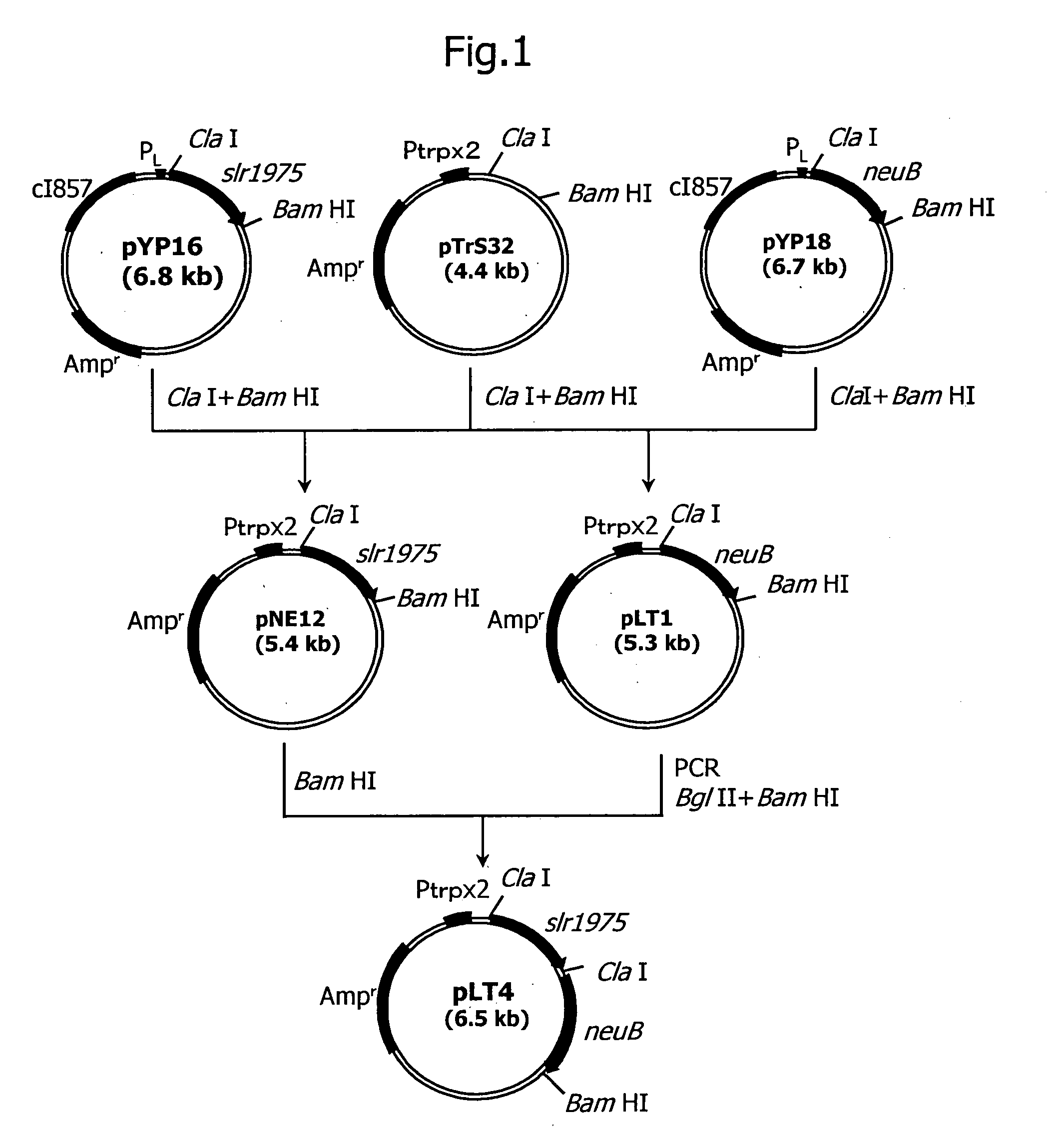Process for producing n-acetylneuraminic acid
- Summary
- Abstract
- Description
- Claims
- Application Information
AI Technical Summary
Benefits of technology
Problems solved by technology
Method used
Image
Examples
example 1
Construction of a Strain Expressing N-Acetylneuraminate Synthase and N-Acetylglucosamine 2-Epimerase
[0264] After cleaving 0.2 μg of pYP18 (Japanese Published Unexamined Patent Application No. 136982 / 00) with restriction enzymes ClaI and BamHI, DNA fragments were separated by agarose gel electrophoresis, and a 1.1 kb DNA fragment comprising N-acetylneuraminate synthase gene derived from Escherichia coli was recovered using Gene Clean II Kit (Funakoshi). Then 0.1 μg of pTrS32 [prepared from Escherichia coli JM109 / pTrS32 (FERM BP-5408)] was cleaved with restriction enzymes ClaI and BamHI, DNA fragments were separated by agarose gel electrophoresis, and a 4.2 kb DNA fragment was recovered in the same manner.
[0265] The 1.1 kb and 4.2 kb fragments were subjected to ligation using a ligation kit (Takara Shuzo) at 16° C. for 16 hours.
[0266]Escherichia coli NM522 was transformed using the ligation mixture according to the known method described above, and the transformant was spread on L...
example 2
Acquisition of a Strain with Activity to Decompose N-Acetylneuraminic Acid Reduced
[0278]Escherichia coli HN0074 (FERM BP-4425) was inoculated into 30 ml of LB medium [10 g / l Bacto-triptone (Difco Laboratories Inc.), 10 g / l yeast extract, 5 g / l sodium chloride] in a 300-ml Erlenmeyer flask and cultured at 28° C. for 5 hours with shaking. The resulting culture was centrifuged at 3,000 r.p.m. at 4° C. for 10 minutes to recover the cells at the logarithmic growth phase. The cells were suspended in TM buffer [6.1 g / l Tris(hydroxymethyl)aminomethane, 5.8 g / l maleic acid, 0.1 g / l magnesium sulfate heptahydrate, 1 g / l ammonium sulfate, 0.5 g / l sodium citrate, pH6.0] containing 0.1 mg / ml N-methyl-N′-nitro-N-nitrosoguanidine, and mutagenesis was carried out at 37° C. for 30 minutes. The cells subjected to mutagenesis were collected by centrifugation, washed and then suspended in sterilized water. The suspension was spread on M9 minimal medium [3 g / l glucose, 6 g / l disodium hydrogenphosphate...
example 3
Production of N-Acetylneuraminic Acid
[0281]Escherichia coli NAN8-71 was transformed using plasmid pLT4 obtained in Example 1, and the transformant obtained was spread on LB agar medium containing 50 μg / ml ampicillin and cultured overnight at 30° C. to obtain Escherichia coli NAN8-71 / pLT4.
[0282]Escherichia coli NAN8-71 / pLT4 was inoculated into 150 ml of LB medium containing 50 μg / ml ampicillin in a 1-1 Erlenmeyer flask with baffles and cultured at 30° C. with shaking at 220 rpm for 17 hours. Then, 150 ml of the culture was inoculated into 3 l of M9 medium [5 g / l glucose, 6 g / l disodium hydrogenphosphate, 3 g / l potassium dihydrogenphosphate, 5 g / l sodium chloride, 1 g / l ammonium chloride, 2.4 g / l magnesium sulfate heptahydrate, 10 mg / l manganese sulfate monohydrate, 200 mg / l ferrous sulfate heptahydrate, 8 mg / l vitamin B1, 5 g / l peptone (Kyokuto Pharmaceutical)] containing 50 μg / ml ampicillin in a 5-1 jar fermentor and cultured at 30° C. for 6.5 hours under the conditions of stirri...
PUM
 Login to View More
Login to View More Abstract
Description
Claims
Application Information
 Login to View More
Login to View More - R&D
- Intellectual Property
- Life Sciences
- Materials
- Tech Scout
- Unparalleled Data Quality
- Higher Quality Content
- 60% Fewer Hallucinations
Browse by: Latest US Patents, China's latest patents, Technical Efficacy Thesaurus, Application Domain, Technology Topic, Popular Technical Reports.
© 2025 PatSnap. All rights reserved.Legal|Privacy policy|Modern Slavery Act Transparency Statement|Sitemap|About US| Contact US: help@patsnap.com

